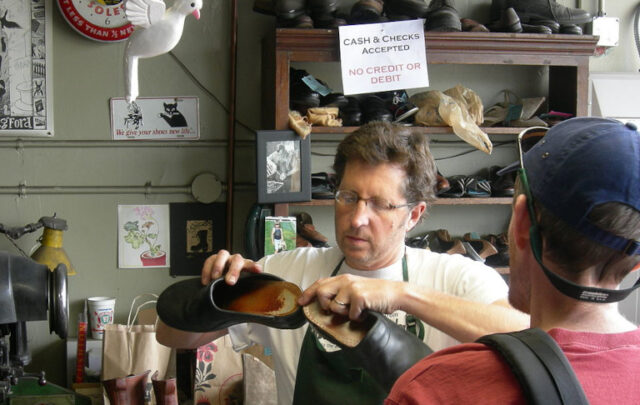Hamilton’s current industrial base will not survive the end of the automobile era. Bicycles could help save it.
As the effects of Peak Oil make themselves felt, they will go far beyond gas prices.
The Canadian auto industry employs around a half million people directly and indirectly, almost all of which is in Ontario. This isn’t just building and selling cars – there’s a massive manufacturing empire needed to mine the ore, make the steel and machine the parts that extends well beyond Ford or Toyota.
This is something we understand all too well in Hamilton. Every time the auto industry hurts, we feel it. All signs at the moment seem to suggest that the pain is only beginning.
So what do we do with two of the nation’s largest steel mills? With a machining and manufacturing capacity spanning the whole north edge of the city? More and more of this is going idle all the time and sending a lot of highly trained professionals home.

Raleigh Safety Bike (Image Credit: Nottinghamshire City Council)

Marinoni Pista (Image Credit: Cycles Marinoni Inc)
In the past, steel was almost always the default material for bike-building. It’s far stronger and more durable than wood, but much cheaper and far less energy-intensive than metals like Titanium and Aluminum. Steel bike frames, well cared for and not run over (too often) last decades, easily.
Steel Bikes: Cheap, Strong, Durable
Right now, on the roads of Hamilton, hundreds of cyclists on old “ten-speed” racers from the 1970s are blasting past many newer, much more expensive bikes. These bikes are the product of a “bicycle boom”, largely as a result of the Oil Shocks, which took the streets of Hamilton and other cities by storm.
Because of their simple construction and high-quality steel tubing, cyclists just keep turning back to them as an alternative to modern frames. Talk to anyone in the Fixed Gear or Singlespeed crowd – these frames are perfect, and available everywhere.

Raleigh Record (Image Credit: Sheldown Brown)
Since then, he bike industry has turned to far less practical machines. Since the 1990s, largely thanks to the boom in mountain bikes (basically the bike equivalent of an SUV), bikes have been getting heavier, more complex and far less practical. These bikes turned cycling from a serious transportation option into hobby or sport, and have played a huge role in the decline of cycling.
The industry did this in two ways. Higher end bikes exploded in price, equipped with space-age technologies designed primarily for the professional racing crowd. These bikes can cost thousands of dollars, which scares off a lot of people who’d like to get into cycling.
On the other side of the coin are those bikes found at stores like Canadian Tire and Wal Mart. While they’re cheap, the quality is cripplingly low. Owning one of these things is one of the best arguments against cycling out there. They’re slow, heavy, and often break down within hours or days of leaving the store. They simply aren’t a serious transportation option.

Supercycle Hooligan (Image Credit: Canadian Tire)
Future for Steel
If cycling is going to catch on as a major means of transportation, somebody’s going to have to start building new affordable and practical bikes. That’s where steel comes in.
Cutting-edge alloys are still being used to build competition-grade racing bikes which are almost as light as aluminum or carbon fiber. Good examples of this would be the Colnago Master X-Lite or the Cinelli XCR.
For those with a more modest budget, talk to Brian at Central Cycle about a Masi or Marinoni.
But more importantly, the technology to build a basic 20 pound bike is now almost ancient. If we can produce a decent quality of steel tubing, most of the rest of the serious work involved in frame-building can be done with hand tools and a TIG welder. Spokes can be made straight from steel wire. Bearings, cups, and bolts are all produced in town already.
People do this kind of thing in their garage or back yard all the time. Hamilton Freeskool had a class on it.
Manufacturing and Distribution
For a large manufacturing facility, this means the option of bringing the price of a decent price down by a lot. The entire industry is waiting for this right now. If you can build a “downhill bike” and retail it for $200, why not something more efficient?
Think of Dell, with its online ordering system combining the benefits of mass production and custom ordering. By shipping locally and directly, costs could be cut further, and savings reinvested into quality production.
Most important, not only would re-tooling a mill to put out high-quality tubing for bike frames mean renewed life for our steel operations, it would open the door to hundreds of small, custom and affordable framebuilding shops.
What’s missing in today’s cheap bikes is a frame worth holding onto, upgrading, or experimenting with. Something which has potential for expansion – which means standard fittings, versatile geometry, and good quality metallurgy. If mass producing this in the 1970s was possible, then why not today? For small-scale operations, this means a lot of options.
High-Skilled, Green, Small-Scale
A custom-built steel frame is nothing to scoff at. This is the kind of high-skilled, green, small-scale employment which Hamilton needs. From frame repairs and modifications to made-to-measure bikes, this is an industry that prizes individual workers and shops over larger operations, and is capable of reaching the whole range of price brackets.
It would permit a lot of immediate work in important areas like trailers, cargo bikes, tandems, recumbents, hybrid-electric
bike-cars (like the Twike) and even tall-bikes. The materials to build even a carbon fiber bike frame in your garage are cheaper than those for many basic auto repairs.
This also provides countless spin-off benefits for everyone from painting shops to component manufacturing.
Whether you’re measuring economic or energy efficiency, bicycles simply deliver far more performance per pound. Though they probably won’t be the only transportation option in the future, there’s little doubt that they’ll play a far larger role than they do today. We can get in on this today, or we can let it pass us by.
Retool for the Future
Green jobs are cool and green economies are even cooler – but this is about more than that.
Five years ago, predicting the death of the automobile era was “crazy talk”. That was before doom and gloom hit GM, Ford and Toyota in the last two years. Cars have dropped in value like rocks, gas prices have exploded and cycling everywhere is getting renewed attention.
But it’s not enough to say “ride a bike”. We can be on the cutting edge of this change, or we can be buried beneath it. Hamilton’s current industrial base will not survive the end of the automobile era. If you doubt the near-apocalyptic potential of these changes, take a drive down to Detriot, and the Rust Belt towns beyond.
We can rebuild and retool for the future, or we can wait for another hundred stadiums to be built to remediate the decaying brownfields of our former employment lands. Preparing for the future means more than talk – it means building alternatives today. That can mean a volunteer-based bike co-op, or it can mean looking at going into full scale production.
Either way, it can’t wait.
See more articles from Raise the Hammer’s Special Report: Peak Oil





